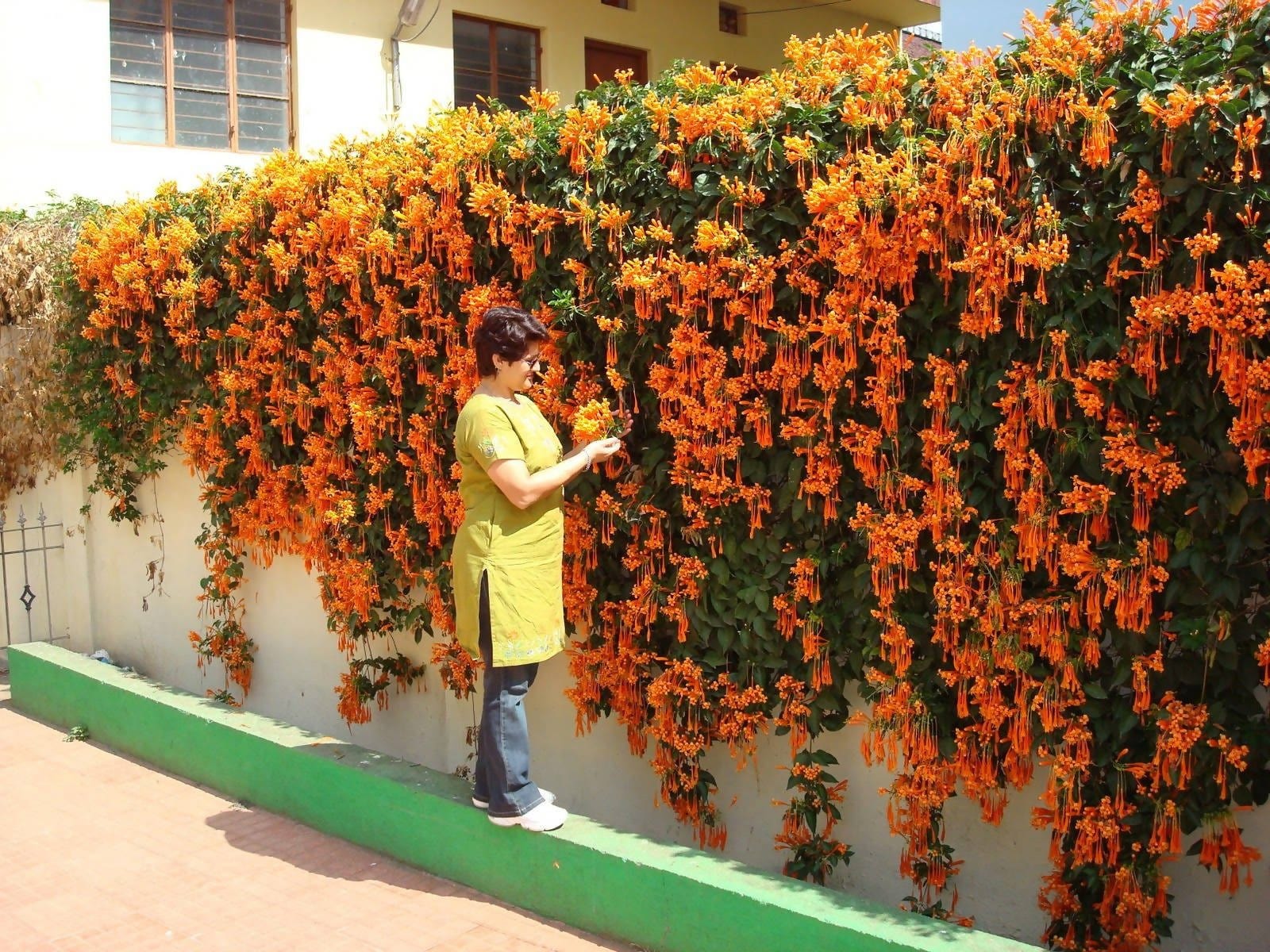North Carolina’s climatic conditions play a significant role in determining the survival and prosperity of hummingbird plants. It’s essential to select plants that can endure the weather extremes prevalent in the region. If the temperatures become excessively hot or cold, these plants might wither away or fail to produce the enticing flowers that hummingbirds rely on for nectar.
The United States Department of Agriculture (USDA) divides the country into 13 distinct zones based on average minimum temperatures. Each state also encompasses various zones. Plants flourish in specific zones and can withstand minimal temperatures but are unable to survive in excessively cold climates.
North Carolina experiences scorching summers and relatively mild winters, thanks to the Appalachian Mountains that serve as a barrier against low temperatures. In terms of plant hardiness zones, North Carolina falls within zones 5 to 8, with the eastern region being milder than the western part.
In addition to cold conditions, excessive heat can also pose challenges for certain plants. To address this, the American Horticultural Society has developed a plant heat-zone map that illustrates the average number of days an area experiences temperatures above 86 degrees Fahrenheit.
North Carolina falls within heat zones 2 to 8, indicating that colder winters pose more significant issues for hummingbird plants compared to heat-related challenges.
To ensure the suitability of the plants for North Carolina’s weather conditions, all the hummingbird plants listed below have been carefully evaluated based on cold and heat zones in the state. These plants not only boast gorgeous nectar-rich flowers that hummingbirds adore but also thrive in North Carolina’s climate.
It’s worth noting that plants categorized under cold zones 7 or 8 may struggle to survive the colder winters in zones 5 or 6 without adequate protection.
Therefore, to attract hummingbirds in North Carolina, it is advisable to plant as many of these flowers as possible.
Hummingbird Plants for North Carolina (Hardiness Zones 5 and 6)
1. Nasturtiums
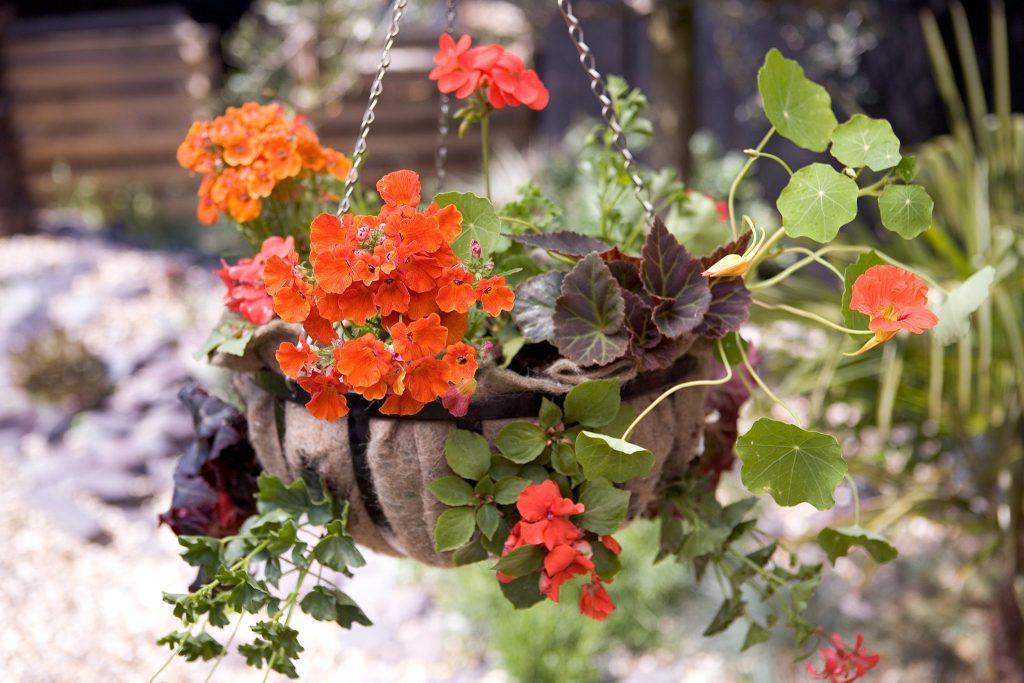
Trailing edible flowers known as Nasturtiums are ideal for creating hanging baskets that attract hummingbirds. These flowers possess rich nectar and deep, specially designed blossoms. Typically grown as annuals, Nasturtiums come in both trailing and bush varieties. Plant the seeds outdoors just after the last frost, ensuring they receive sufficient watering during the growing season. Deadheading is also necessary.
Common Name: Nasturtiums
Scientific Name: Tropaeolum
Growing Zones: 2 – 11
Sun: Full
Soil: Well-drained
Colors: Red, orange, yellow, pink
Height: 1 – 10 feet
Spread: 1 – 3 feet
Plant Type: Annual
2. Zinnia

Zinnias are flowering shrubs native to North America’s scrublands and dry grasslands. They belong to the sunflower tribe (Heliantheae) within the Asteraceae family, which is the larger daisy family.
Zinnias can be categorized into three main types based on their petal structure: single-flowered, double-flowered, and semi-double-flowered. Single-flowered zinnias have a visible center and a single row of petals, while double-flowered zinnias lack a visible center and feature multiple rows of petals. Semi-double-flowered zinnias possess numerous rows with visible centers.
The Zinnia elegans, known for its tall stems and vibrant colors, is a classic choice popular among backyard and garden enthusiasts. Reaching heights of 4 feet, these zinnias boast a profusion of brilliantly colored flowers, offering a long blooming period from early summer until the arrival of frost. Furthermore, their blossoms attract not only hummingbirds but also butterflies and other pollinators.
Growing zinnias is a straightforward process. It’s best to sow the seeds directly in the desired location since these plants do not respond well to transplantation. Once established under full sun and well-draining soil, these zinnias will reward you with their radiant blooms for an extended duration.
Common Name: Zinnia
Scientific Name: Zinnia elegans
Growing Zones: Annuals in 2-8, Perennials in 9-11
Sun: Full sun
Soil: Neutral to slightly alkaline, well-draining
Colors: White, yellow, orange, pink, red, purple
Height: 1 – 4 feet tall
Spread: 12 – 18 feet wide
Plant Type: Annual, Perennial Shrubs
3. Agastache
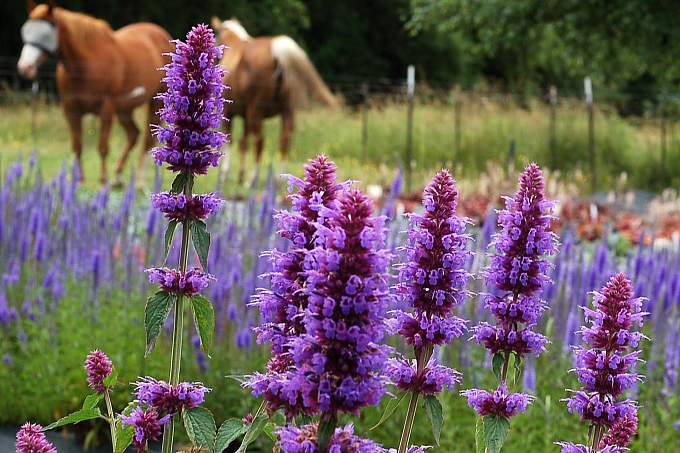
Agastache, pronounced as “ah-GAH-stuh-kee,” comprises aromatic herbaceous perennials encompassing around 22 species, the majority of which are native to North America. They are commonly referred to as “hummingbird mints” and “Giant hyssops.” Aside from their appeal to hummingbirds, they can also be used to prepare herbal tea.
Agastache flowers captivate hummingbirds due to their distinctive appearance amidst the foliage. These flowers, growing in clusters, consist of numerous tiny flowers, which collectively form fuzzy, 3 to 4-inch-long inflorescences. The striking purple and red hues of these flowers serve as irresistible beacons for hummingbirds, particularly when they reach full bloom during the summer.
For optimal growth, it is recommended to start Agastache plants indoors in May and then transplant them into flower beds during the summer. These plants require full sun exposure and regular watering during their establishment phase. However, once they are established, they exhibit drought tolerance and can thrive without frequent attention.
Since Agastache plants hail from desert regions, they possess the ability to withstand scorching temperatures. Once established, they do not require excessive watering, as overwatering can lead to root rot. A generous splash of water followed by allowing the soil to dry out is sufficient.
Common Name: Agastache, Hummingbird Mint, Hyssop
Scientific Name: Agastache
Growing Zones: 3 – 10
Sun: Full Sun
Soil: Lean soil, well-drained
Colors: Blue, purple, red, orange, pink, white
Height: 3 to 5 feet tall
Spread: Varies
Plant Type: Herbaceous perennial
4. Morning Glory

Morning Glory is a collective term for over 1,000 species of flowering plants belonging to the Convolvulaceae family. These plants earned their name due to their flowers opening early in the morning and closing as the day heats up. However, certain species, such as Ipomoea alba, bloom at night instead of during the day.
Morning glory flowers are known for their vibrant and colorful blooms, rapid vine growth, bright green foliage, and their ability to tolerate poor and dry soils. They are often trained to climb arbors or allowed to crawl along the exterior walls of houses with the help of trellises.
One particularly popular species of Morning Glory that entices hummingbirds is Ipomoea purpurea. It exhibits bright purple, trumpet-shaped flowers and heart-shaped leaves that unfurl in the morning and retract in the afternoon. These flowers bloom from early summer until the onset of fall.
While Morning Glory is an annual vine, it can exhibit perennial characteristics in milder climates. It’s crucial to provide Morning Glories with full sun exposure, ideally around 8 hours of sunlight daily, to facilitate optimal blooming.
It’s important to note that Morning Glories can become invasive if not properly maintained due to their vigorous growth. Additionally, their seeds are toxic if consumed, so it’s advisable to keep children and pets away from the plant.
Common Name: Morning Glory, Common Morning Glory
Scientific Name: Convolvulaceae family
Growing Zones: 2 – 11
Sun: Full sun
Soil: Moist, well-draining
Colors: White, pink, purple, blue
Height: 6 – 10 feet tall
Spread: 3 – 6 feet wide
Plant Type: Annual
5. Impatiens
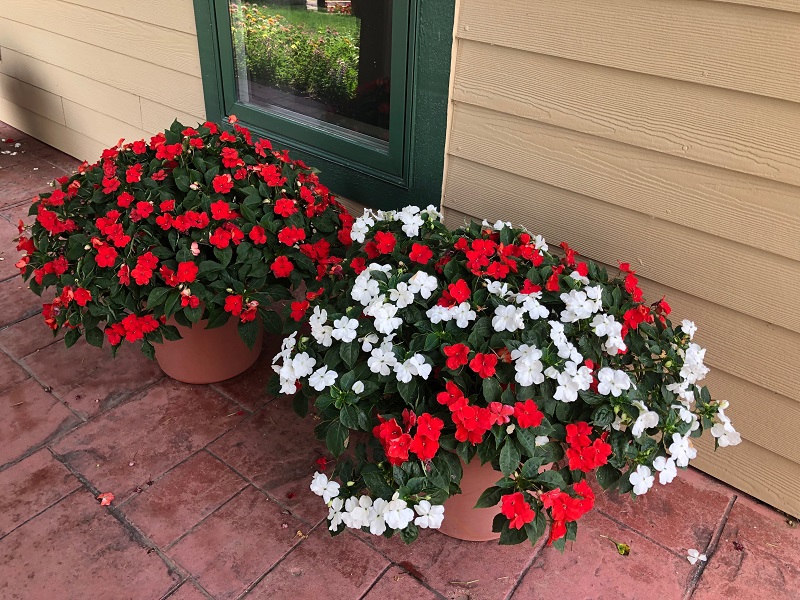
Impatiens, bright and colorful annuals, excel at bringing vibrancy to shady and dark areas while attracting hummingbirds. These plants thrive in moist, well-draining soil and deep shade, making them suitable for hanging on porches.
Impatiens are typically grown from nursery-bought plants arranged closely together to create dense mats of flowers and leaves. Alternatively, seeds can be collected from existing plants and sown indoors around 10 weeks before the last frost, as they require a significant amount of time to flower. Cuttings can also be taken in the fall and grown indoors until the frost subsides.
Common Name: Impatiens, Jewelweed, Touch-me-not, Snapweed, Patience
Scientific Name: Impatiens
Growing Zones: 2 – 11
Sun: Shade or partial shade
Soil: Rich, well-draining
Colors: Red, pink, purple, yellow, coral
Height: 6 – 36 inches
Spread: 1 – 3 feet
Plant Type: Annual
6. Columbine
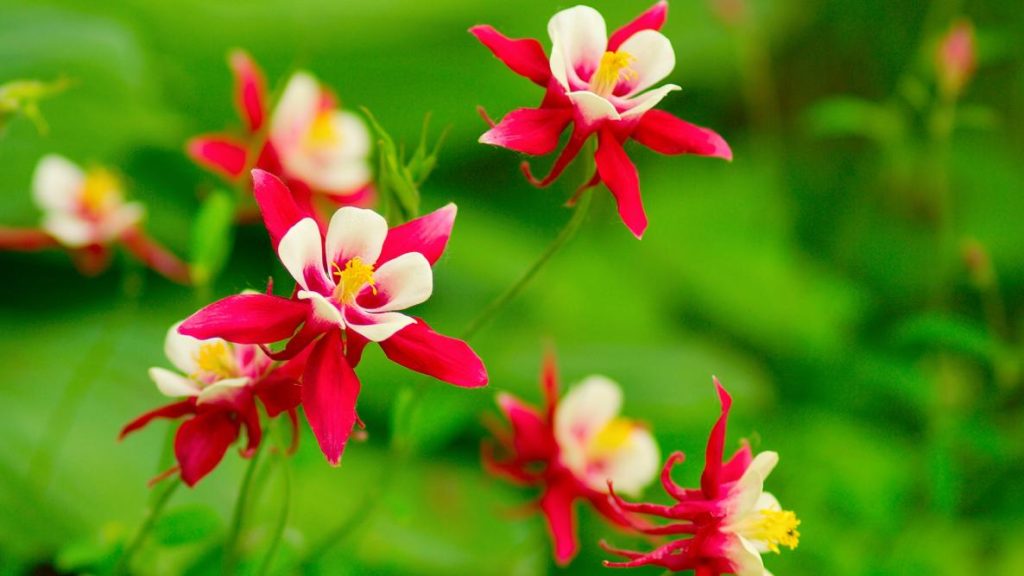
Columbines rank among the top plants for attracting hummingbirds due to their vibrant range of colors and ability to thrive in partial shade. These elegant perennial plants feature spiky, bell-shaped blooms measuring 3 to 6 inches in length. They are also referred to as Aquilegia.
Various columbine varieties are available, but most prefer growing in areas with partial shade to full shade. They often bloom as early as spring, making them an excellent choice for hummingbird attraction.
Columbines are not only shade-tolerant but also exhibit drought tolerance and resistance to deer. To grow them, simply sow the seeds directly into the ground during spring. If desired, seeds can be sown indoors 6 to 8 weeks prior to the last frost. However, it’s important to note that seed-grown plants typically do not produce flowers until their second year.
Common Name: Columbine, Aquilegia
Scientific Name: Aquilegia
Growing Zones: 3-9
Sun: Full sun to partial shade
Soil: Neutral pH, moist but not saturated
Colors: Red, pink, blue, orange, white, yellow
Height: 1 – 3 feet
Spread: 1 foot
Plant Type: Perennial
7. Coneflower
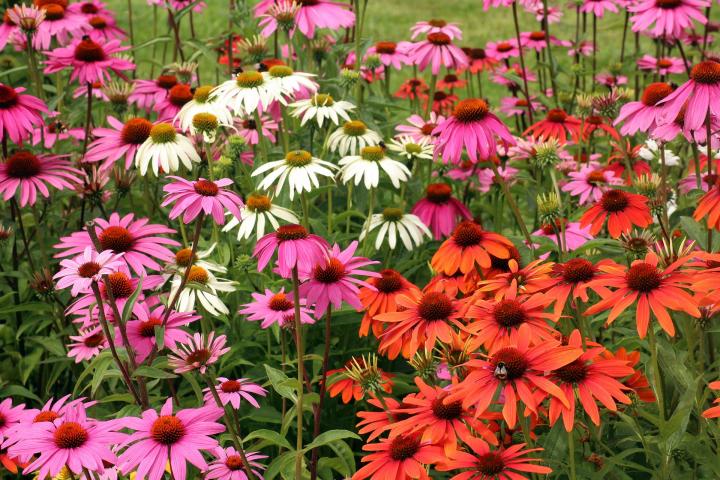
Coneflower is the common name for Echinacea, a genus of flowering plants belonging to the Asteraceae family. Echinacea, derived from Greek, translates to “sea urchin,” alluding to the plant’s shiny central disk.
Coneflowers encompass ten different species, characterized by downward-pointing petals once the central flower head opens, forming a cone-like shape. The most prevalent ornamental coneflower in backyard settings is Echinacea purpurea, also known as the purple coneflower, native to eastern North America.
Coneflowers typically exhibit large, six-inch-wide blossoms on stalks that can reach up to five feet in height. The flowers come in a variety of colors, including pink, red, orange, yellow, white, and purple, depending on the specific species. These plants thrive in full sun and well-drained soil. Coneflowers bloom abundantly from summer to fall, attracting hummingbirds, bees, and butterflies due to their nectar-rich central cones.
Common Name: Coneflower
Scientific Name: Echinacea
Growing Zones: 3 – 9
Sun: Full Sun
Soil: Varies
Colors: White, yellow, orange, pink, red, purple, green
Height: 2 to 5 feet tall
Spread: 1 ½ – 2 feet wide
Plant Type: Perennial
8. Penstemon
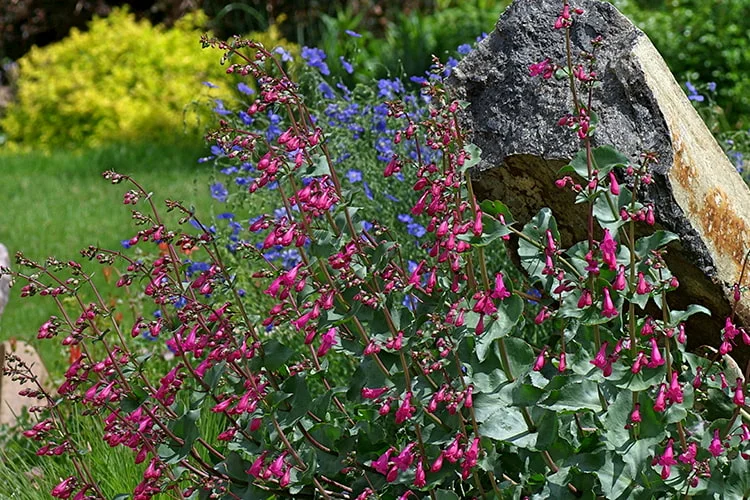
Penstemon, comprising over 250 ornamental flowering plants, is a genus within the Plantaginaceae family, sharing similarities with snapdragons and foxgloves. It is often referred to as Beardtongue due to the tuft of small hairs present on the pollen-free stamen protruding from its flowers.
With numerous species and varieties available, there is a wide selection of Penstemon plants suitable for various backyard settings. All Penstemon species share common traits—they are drought-tolerant, attract hummingbirds and bees, require minimal maintenance, and brighten up any garden with their delightful blooms.
Flowering in early summer, Penstemon plants serve as focal points in garden landscapes, boasting spires adorned with clusters of colorful tubular flowers. Depending on the chosen variety, these flowers can display shades of blue, purple, red, orange, white, pink, and yellow.
Hummingbirds are particularly drawn to Penstemon plants due to their vivid colors and nectar-rich blossoms.
Optimal growth for Penstemons is achieved through full sunlight exposure. When planted in shady areas, their flowers tend to bloom less profusely, and the stems may droop. These plants prefer nutrient-poor soil with moderate moisture. While they exhibit drought tolerance, periodic watering is beneficial. It is advisable to select a variety suited to your soil and climate conditions for extended longevity.
Common Name: Penstemon, Foxglove Beard-tongue, Talus Slope Penstemon, White Beardtongue
Scientific Name: Penstemon
Growing Zones: 3 – 9
Sun: Full sun
Soil: Lean, fast-draining soil
Colors: Blue, purple, red, orange, white, pink, yellow
Height: 6 to 12 inches, 1 to 3 feet, 3 to 8 feet
Spread: 8 to 20 inches
Plant Type: Perennial
9. Summersweet
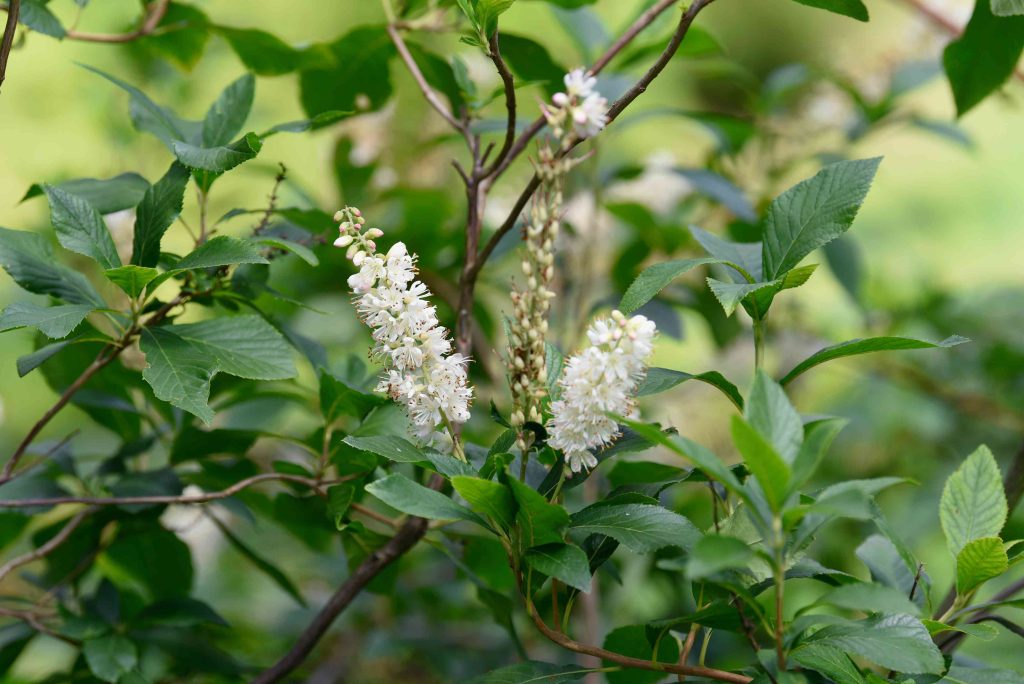
Summersweet, a flowering shrub, not only adds beauty to your backyard but also entices hummingbirds to visit.
Scientifically known as Clethra alnifolia, Summersweet belongs to the Clethraceae family and is native to eastern North America. These shrubs thrive in various climates, particularly in wetlands, ponds, and stream edges.
Summersweet stands out with its vertical spikes of spicy-smelling white flowers set against dark green foliage. During autumn, the green leaves transition to yellow or gold hues. The name “pepperbush” stems from the brown seed capsules, resembling peppercorns, that drop after the flowers bloom.
Blooming between July and August, Summersweet flowers are 2 to 6 inches long and come in white or pink hues. Their faintly fragrant scent is highly attractive to butterflies, hummingbirds, and other pollinators. Additionally, the pepper-like seeds serve as a magnet for birds during autumn.
As coastal flowers, Summersweet thrives in moist to wet soil and shade. In fact, these flowers produce larger blooms in shaded areas compared to those exposed to excessive sunlight. Adequate hydration is crucial, especially during dry spells. Summersweet exhibits tolerance to salty air, as it is native to coastal regions.
To ensure proper care, provide ample space for Summersweet shrubs to spread, as they tend to grow wide. Maintain soil moisture and prune old branches during spring to encourage new growth and maintain the desired shape of the shrub.
Common Name: Summersweet, Coastal Sweet Pepperbush
Scientific Name: Clethra alnifolia
Growing Zones: 3 – 9
Sun: Full sun or partial shade
Soil: Moist to wet soil, slightly acidic
Colors: White, pink, rose-colored
Height: 4 – 8 feet tall
Spread: 4 – 6 feet wide
Plant Type: Perennial, Deciduous shrub
10. Yarrow

Yarrow, scientifically known as Achillea millefolium, carries several intriguing folklore tales. Its scientific name pays homage to the mythical Greek hero Achilles, who reputedly used yarrow to treat his soldiers’ wounds.
Yarrow has also been referred to as “Nosebleed” due to its alleged ability to initiate or halt nosebleeds. The name “millefolium” translates to “thousand leaves,” describing the plant’s feathery foliage that appears divided into numerous tiny leaflets.
Common Yarrow is a popular choice in many backyards, thanks to its charming clusters of tiny flowers available in white, yellow, pink, or red, depending on the variety. These clusters typically comprise 15 to 40 flowers tightly arranged on their stems.
Yarrow leaves are equally beautiful, distributed evenly along the stem, measuring 2 to 8 inches in length. The lower and middle leaves tend to be larger. These aromatic leaves possess a soft, fern-like appearance.
Aside from attracting hummingbirds, bees, and butterflies, the Common Yarrow boasts several medicinal uses. It has been traditionally employed in the treatment of wounds, burns, colds, fevers, and headaches.
Common Name: Common Yarrow, Milfoil, Nosebleed, Thousand-leaf
Scientific Name: Achillea millefolium
Growing Zones: 3 – 9
Sun: Full sun
Soil: Sandy, loamy, clay, well-draining
Colors: White, yellow, pink, red
Height: 2 to 3 feet tall
Spread: 2 to 3 feet wide
Plant Type: Perennial
11. Butterfly Bush
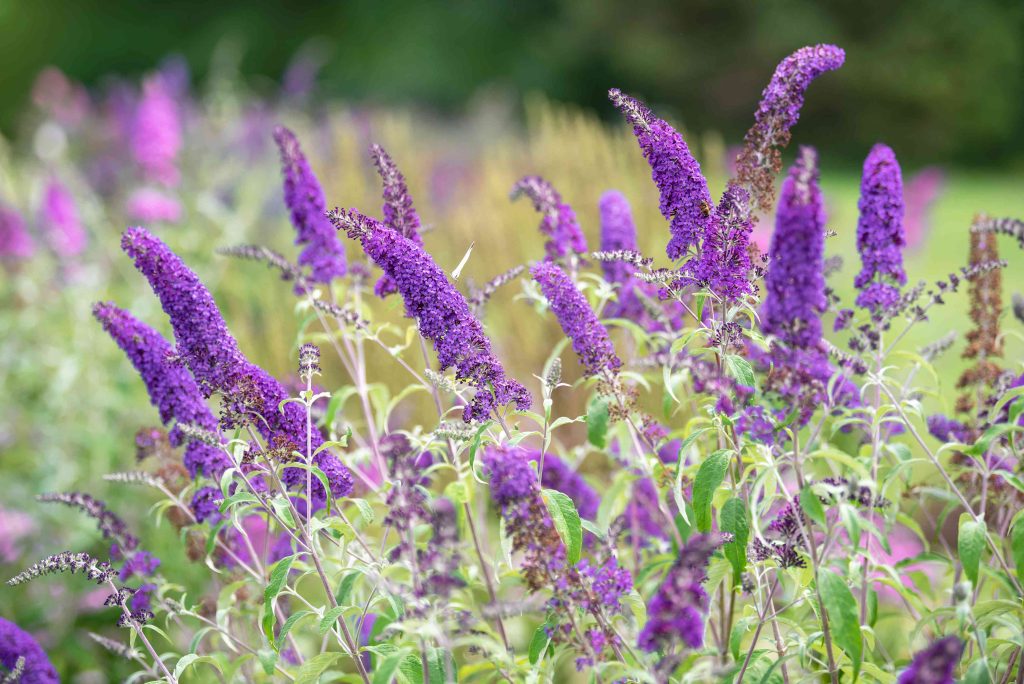
Butterfly Bush, scientifically known as Buddleja, is a popular choice for attracting hummingbirds and butterflies to your garden. These shrubs produce long, cone-shaped clusters of flowers that come in various vibrant colors, including purple, pink, white, and yellow.
The nectar-rich flowers of Butterfly Bush are highly attractive to hummingbirds, butterflies, and other pollinators. These plants bloom from summer to fall, providing a continuous food source for these winged visitors.
Butterfly Bushes thrive in full sun and well-draining soil. They are relatively low-maintenance and require occasional pruning to maintain their shape and promote new growth.
Common Name: Butterfly Bush
Scientific Name: Buddleja
Growing Zones: 5 – 9
Sun: Full sun
Soil: Well-draining
Colors: Purple, pink, white, yellow
Height: 6 – 12 feet
Spread: 4 – 15 feet
Plant Type: Shrub
12. Cardinal Flower
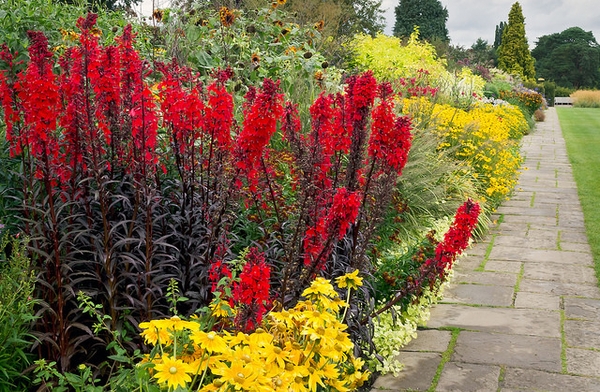
Cardinal Flower, or Lobelia cardinalis, is a stunning perennial that attracts hummingbirds with its bright red, tubular flowers. Native to North America, these plants thrive in wet or moist conditions, making them a great choice for rain gardens or along the edges of ponds and streams.
The Cardinal Flower grows tall, reaching heights of 2 to 4 feet, and blooms in late summer. Its vibrant red flowers are known to be a favorite of hummingbirds, who are drawn to the rich nectar within.
For optimal growth, plant Cardinal Flowers in partial shade to full sun and in well-draining soil. Regular watering is necessary to maintain moist conditions.
Common Name: Cardinal Flower
Scientific Name: Lobelia cardinalis
Growing Zones: 3 – 9
Sun: Partial shade to full sun
Soil: Moist, well-draining
Color: Red
Height: 2 – 4 feet
Spread: 1 – 2 feet
Plant Type: Perennial
13. Trumpet Vine
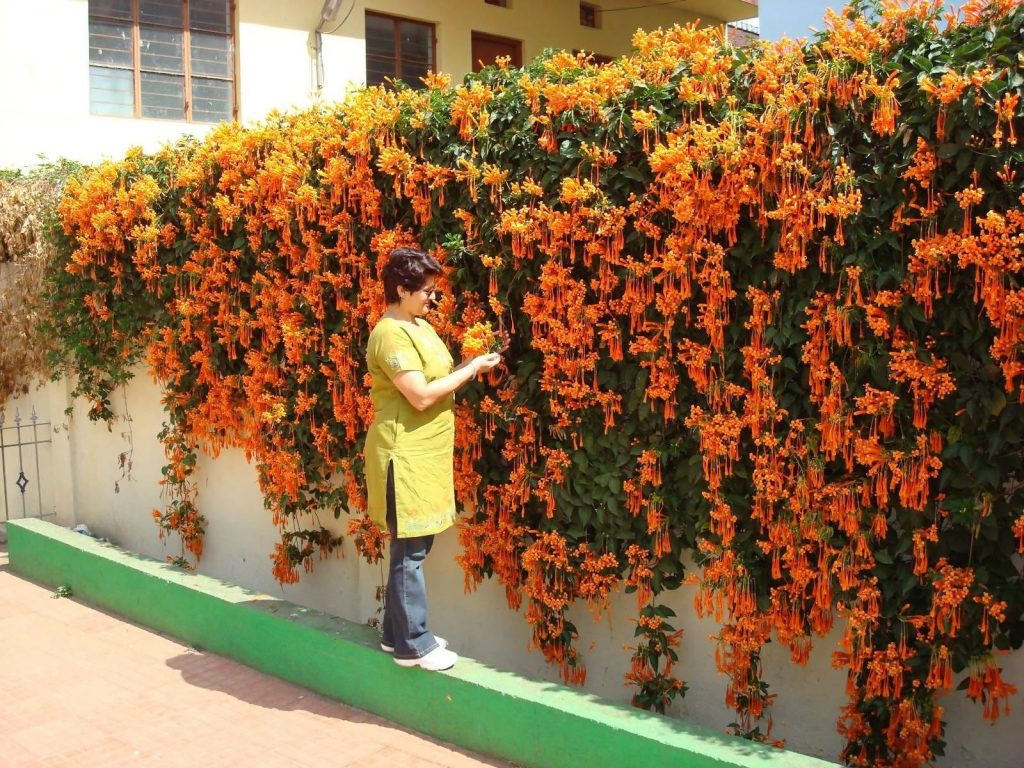
Trumpet Vine, scientifically known as Campsis radicans, is a vigorous climbing vine that produces stunning trumpet-shaped flowers in vibrant shades of red, orange, and yellow. These flowers are a favorite of hummingbirds due to their shape and nectar content.
Trumpet Vines are well-suited for trellises, arbors, or fences where they can climb and provide a vertical element in your garden. They thrive in full sun and well-draining soil.
It’s important to note that Trumpet Vines can be aggressive growers and require regular pruning to keep them in check. Additionally, they may take a few years to establish and start blooming, but once they do, the hummingbirds will be drawn to their showy flowers.
Common Name: Trumpet Vine
Scientific Name: Campsis radicans
Growing Zones: 4 – 9
Sun: Full sun
Soil: Well-draining
Colors: Red, orange, yellow
Height: Up to 30 feet
Spread: 5 – 10 feet
Plant Type: Vine
14. Salvia

Salvia, also known as Sage, is a diverse genus of flowering plants that includes both perennial and annual varieties. Many Salvia species produce tubular flowers that hummingbirds find irresistible.
There are numerous Salvia species and cultivars to choose from, with flower colors ranging from shades of blue and purple to red, pink, and white. Some popular hummingbird-attracting Salvia varieties include Salvia guaranitica, Salvia greggii, and Salvia splendens.
Salvias generally prefer full sun and well-draining soil. They are relatively low-maintenance and require minimal watering once established. Regular deadheading can promote continuous blooming throughout the season.
Common Name: Salvia, Sage
Scientific Name: Salvia
Growing Zones: Varies depending on species
Sun: Full sun
Soil: Well-draining
Colors: Blue, purple, red, pink, white
Height: Varies depending on species
Spread: Varies depending on species
Plant Type: Perennial or annual, depending on species
15. Coral Honeysuckle

Coral Honeysuckle, scientifically known as Lonicera sempervirens, is a twining vine that produces clusters of tubular flowers in vibrant shades of coral, orange, and red. These flowers are highly attractive to hummingbirds, which are drawn to their sweet nectar.
This native North American vine is an excellent choice for arbors, fences, or trellises where it can climb and create a beautiful display. Coral Honeysuckle thrives in full sun to partial shade and well-draining soil.
In addition to attracting hummingbirds, Coral Honeysuckle provides habitat and food for other wildlife, including butterflies and bees. It’s a versatile and low-maintenance plant that can add a splash of color to your garden.
Common Name: Coral Honeysuckle
Scientific Name: Lonicera sempervirens
Growing Zones: 4 – 10
Sun: Full sun to partial shade
Soil: Well-draining
Colors: Coral, orange, red
Height: Up to 20 feet
Spread: 3 – 6 feet
Plant Type: Vine
16. Red Hot Poker
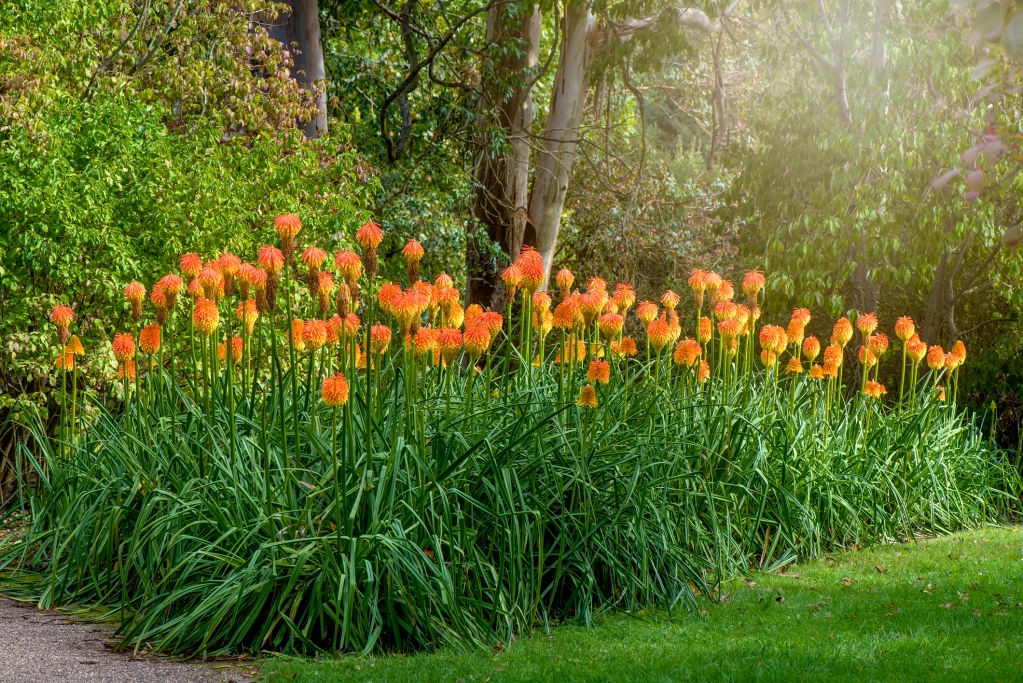
Red Hot Poker, scientifically known as Kniphofia, is a striking perennial plant that attracts hummingbirds with its unique torch-like flower spikes. The flowers are usually red, orange, or yellow, creating a fiery display in the garden.
Red Hot Poker plants prefer full sun and well-draining soil. They are drought-tolerant once established and require minimal watering. These plants are known for their resilience in hot and dry conditions.
Hummingbirds are particularly drawn to the nectar-rich flowers of Red Hot Poker, and their long beaks are perfectly suited for accessing the deep flowers.
Common Name: Red Hot Poker
Scientific Name: Kniphofia
Growing Zones: 5 – 9
Sun: Full sun
Soil: Well-draining
Colors: Red, orange, yellow
Height: 2 – 5 feet
Spread: 1 – 3 feet
Plant Type: Perennial
17. Bee Balm
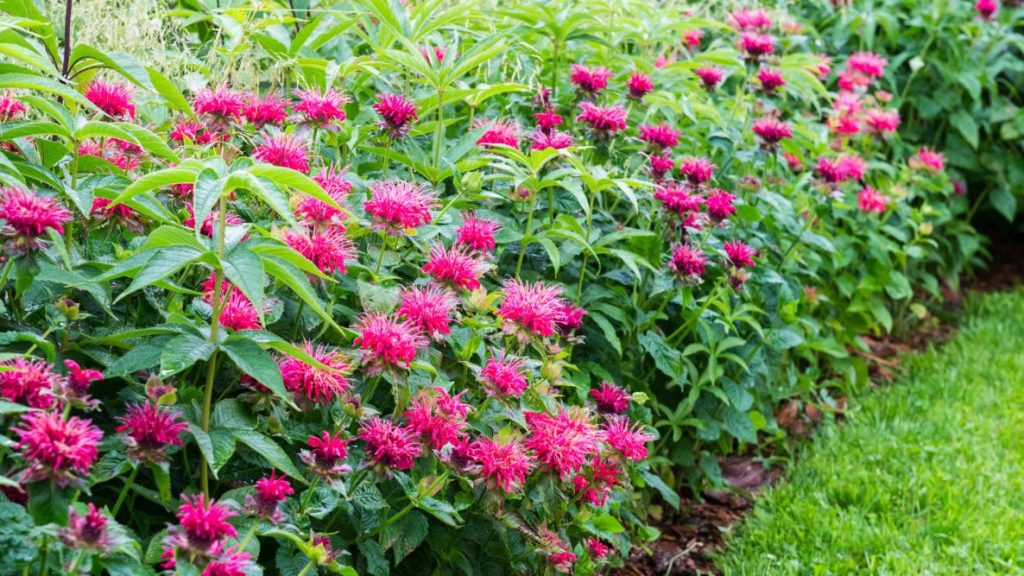
Bee Balm, or Monarda, is a lovely perennial plant that not only attracts bees but also hummingbirds with its vibrant and nectar-rich flowers. These plants produce clusters of tubular flowers in shades of red, pink, purple, and white.
Bee Balm prefers full sun to partial shade and well-draining soil. Regular watering is necessary to keep the soil consistently moist. It’s worth noting that Bee Balm can be susceptible to powdery mildew, so good air circulation is important.
The unique tubular shape of Bee Balm’s flowers makes them an excellent choice for hummingbirds. These birds can hover in front of the flowers and easily access the nectar with their long beaks.
Common Name: Bee Balm
Scientific Name: Monarda
Growing Zones: 3 – 9
Sun: Full sun to partial shade
Soil: Well-draining
Colors: Red, pink, purple, white
Height: 2 – 4 feet
Spread: 1 – 3 feet
Plant Type: Perennial
18. Cardinal Climber
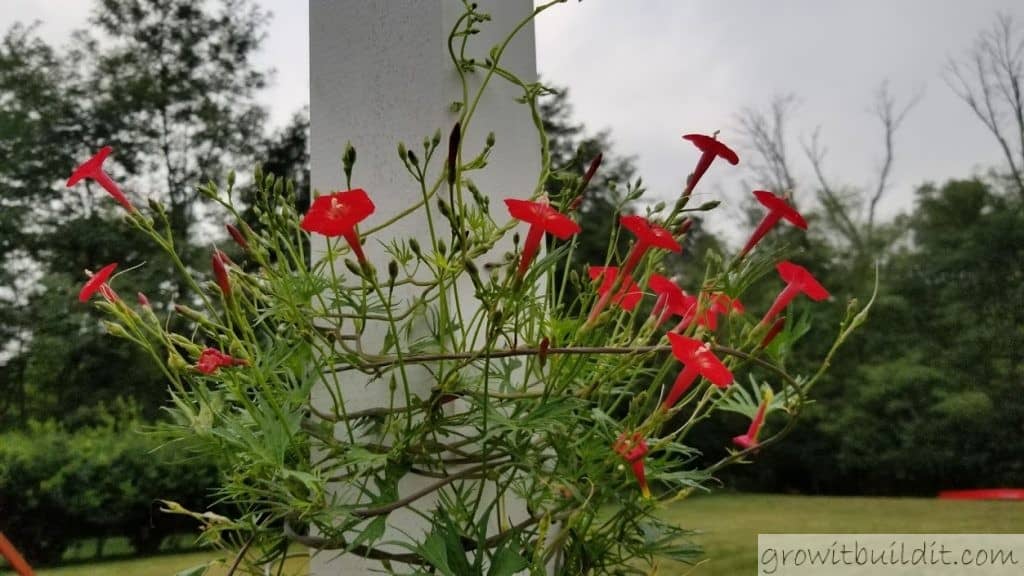
Cardinal Climber, scientifically known as Ipomoea sloteri, is a fast-growing annual vine that produces brilliant red,
trumpet-shaped flowers. These flowers are highly attractive to hummingbirds, who are drawn to their nectar.
This vine is often used for vertical accents in the garden, and it can climb on trellises, fences, or arbors. Cardinal Climber thrives in full sun and well-draining soil.
Due to its rapid growth, Cardinal Climber requires sturdy support and regular pruning to prevent it from becoming too unruly. Its vibrant red flowers are a magnet for hummingbirds, adding a pop of color and attracting these delightful visitors to your garden.
Common Name: Cardinal Climber
Scientific Name: Ipomoea sloteri
Growing Zones: Annual
Sun: Full sun
Soil: Well-draining
Color: Red
Height: Up to 10 feet
Spread: 1 – 2 feet
Plant Type: Annual Vine
19. Bleeding Heart

Bleeding Heart, or Lamprocapnos spectabilis, is a captivating perennial plant known for its unique heart-shaped flowers. These flowers dangle from arching stems and come in shades of pink and white, resembling delicate ornaments.
While Bleeding Heart primarily attracts bees and butterflies, hummingbirds may occasionally visit the flowers for nectar. The distinct shape and vibrant colors of the flowers make them visually appealing to these winged visitors.
Bleeding Heart prefers partial shade to full shade and moist, well-draining soil. Regular watering is essential to maintain the desired soil moisture levels. These plants provide a touch of elegance to shaded areas of the garden and can serve as a charming backdrop for other hummingbird-attracting plants.
Common Name: Bleeding Heart
Scientific Name: Lamprocapnos spectabilis
Growing Zones: 3 – 9
Sun: Partial shade to full shade
Soil: Moist, well-draining
Colors: Pink, white
Height: 2 – 3 feet
Spread: 2 – 3 feet
Plant Type: Perennial
20. Trumpet Creeper
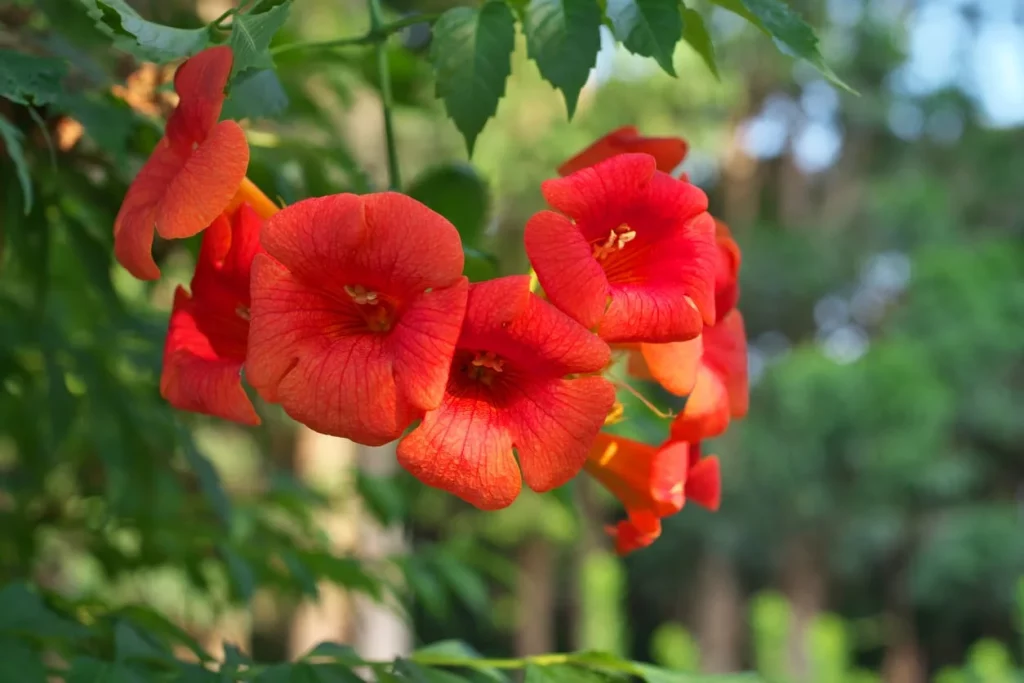
Trumpet Creeper, scientifically known as Campsis radicans, is a vigorous deciduous vine that produces large trumpet-shaped flowers in vibrant shades of red, orange, or yellow. These showy flowers are highly attractive to hummingbirds.
Trumpet Creepers are excellent climbers and can be trained to grow on arbors, trellises, or fences. They thrive in full sun and well-draining soil.
Due to their vigorous growth, Trumpet Creepers require regular pruning to keep them in check. Their abundant nectar-filled flowers make them irresistible to hummingbirds, creating a lively display of activity in your garden.
Common Name: Trumpet Creeper
Scientific Name: Campsis radicans
Growing Zones: 4 – 9
Sun: Full sun
Soil: Well-draining
Colors: Red, orange, yellow
Height: Up to 30 feet
Spread: 5 – 10 feet
Plant Type: Vine
21. Foxglove
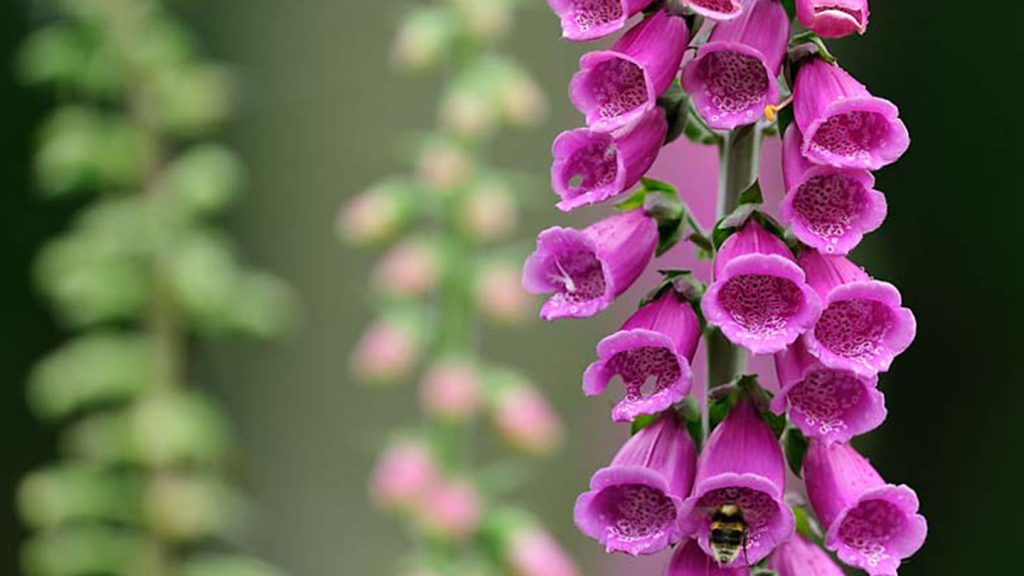
Foxglove, scientifically known as Digitalis, is a tall and elegant biennial or perennial plant that produces tall spikes of tubular flowers. These flowers are often spotted inside and come in shades of pink, purple, white, and yellow.
While primarily attracting bees and butterflies, Foxglove can also be visited by hummingbirds, especially those with long beaks that can access the nectar within the tubular flowers.
Foxgloves prefer partial shade to full sun and well-draining soil. They can add vertical interest to the garden with their tall flower spikes and provide a charming backdrop for other hummingbird-friendly plants.
Common Name: Foxglove
Scientific Name: Digitalis
Growing Zones: Varies depending on species
Sun: Partial shade to full sun
Soil: Well-draining
Colors: Pink, purple, white, yellow
Height: Varies depending on species
Spread: Varies depending on species
Plant Type: Biennial or perennial, depending on species
22. Columbine
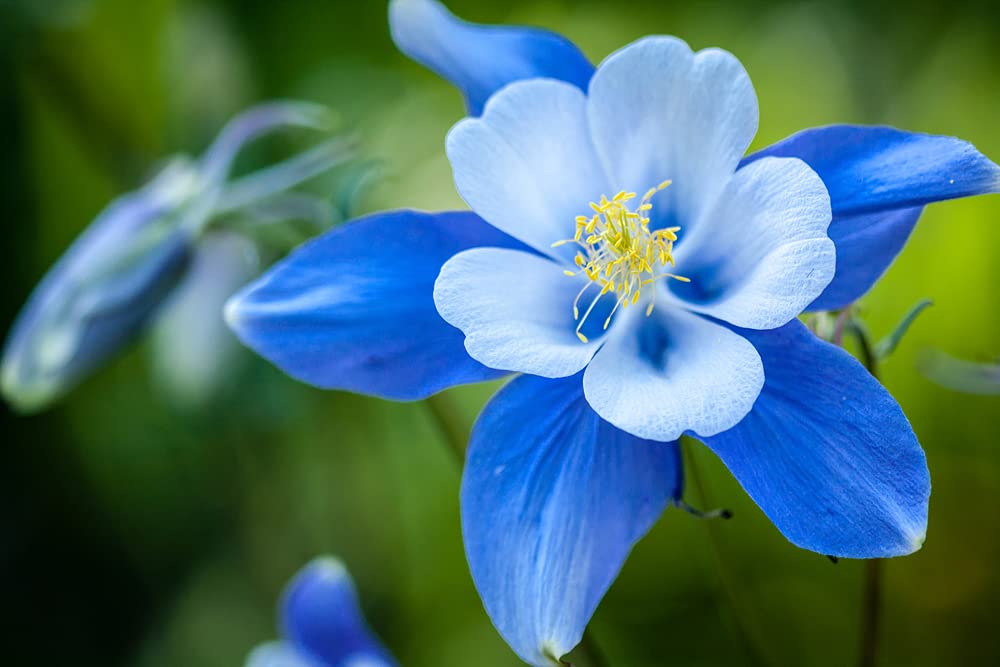
Columbine, scientifically known as Aquilegia, is a graceful perennial plant that attracts hummingbirds with its unique, spurred flowers. These flowers come in a wide range of colors, including shades of red, pink, blue, purple, and yellow.
The intricate shape of Columbine flowers, with their spurs filled with nectar, makes them perfectly suited for hummingbirds with their long beaks.
Columbines prefer partial shade to full sun and moist, well-draining soil. They are a delightful addition to woodland gardens, shady borders, or rock gardens, where their charming blooms can be appreciated by both hummingbirds and garden enthusiasts.
Common Name: Columbine
Scientific Name: Aquilegia
Growing Zones: 3 – 9
Sun: Partial shade to full sun
Soil: Moist, well-draining
Colors: Red, pink, blue, purple, yellow
Height: 1 – 3 feet
Spread: 1 foot
Plant Type: Perennial
23. Red Buckeye

Red Buckeye, or Aesculus pavia, is a deciduous shrub or small tree native to the southeastern United States. It produces dense clusters of tubular red flowers in spring, which are highly attractive to hummingbirds.
Red Buckeye prefers full sun to partial shade and well-draining soil. It can tolerate a wide range of soil types and is relatively low-maintenance once established.
This plant’s vibrant red flowers, coupled with its moderate size, make it an excellent addition to gardens and natural areas where hummingbirds can easily access the nectar within the tubular blooms.
Common Name: Red Buckeye
Scientific Name: Aesculus pavia
Growing Zones: 4 – 8
Sun: Full sun to partial shade
Soil: Well-draining
Color: Red
Height: 10 – 20 feet
Spread: 10 – 15 feet
Plant Type: Shrub or small tree
24. Weigela

Weigela is a genus of deciduous shrubs known for their attractive funnel-shaped flowers, which come in shades of pink, red, or white. These flowers are a favorite of hummingbirds due to their abundant nectar.
Weigelas prefer full sun to partial shade and well-draining soil. They are relatively low-maintenance plants and can add a splash of color to borders, hedges, or mixed shrub plantings.
Hummingbirds will be drawn to the showy flowers of Weigela, and their frequent visits will provide an animated display in your garden.
Common Name: Weigela
Scientific Name: Weigela
Growing Zones: Varies depending on species
Sun: Full sun to partial shade
Soil: Well-draining
Colors: Pink, red, white
Height: Varies depending on species
Spread: Varies depending on species
Plant Type: Shrub
25. Cardinal Flower Vine
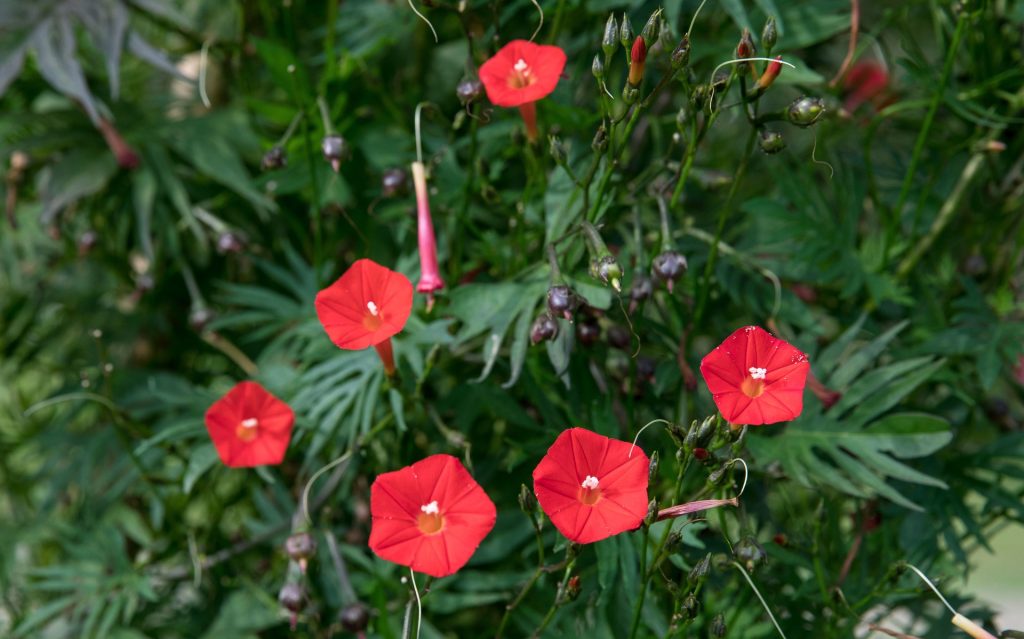
Cardinal Flower Vine, or Tropaeolum speciosum, is a vigorous climbing vine that produces stunning scarlet flowers resembling little cardinal hats. These flowers are a favorite of hummingbirds, who are attracted to their bright color and rich nectar.
This vine thrives in full sun to partial shade and well-draining soil. It requires sturdy support, such as a trellis or fence, to climb and showcase its vibrant blooms.
Cardinal Flower Vine is known for its ability to attract hummingbirds from afar, making it a fantastic addition to any hummingbird garden.
Common Name: Cardinal Flower Vine
Scientific Name: Tropaeolum speciosum
Growing Zones: 6 – 9
Sun: Full sun to partial shade
Soil: Well-draining
Color: Scarlet
Height: Up to 10 feet
Spread: 2 – 3 feet
Plant Type: Vine
26. Cape Honeysuckle
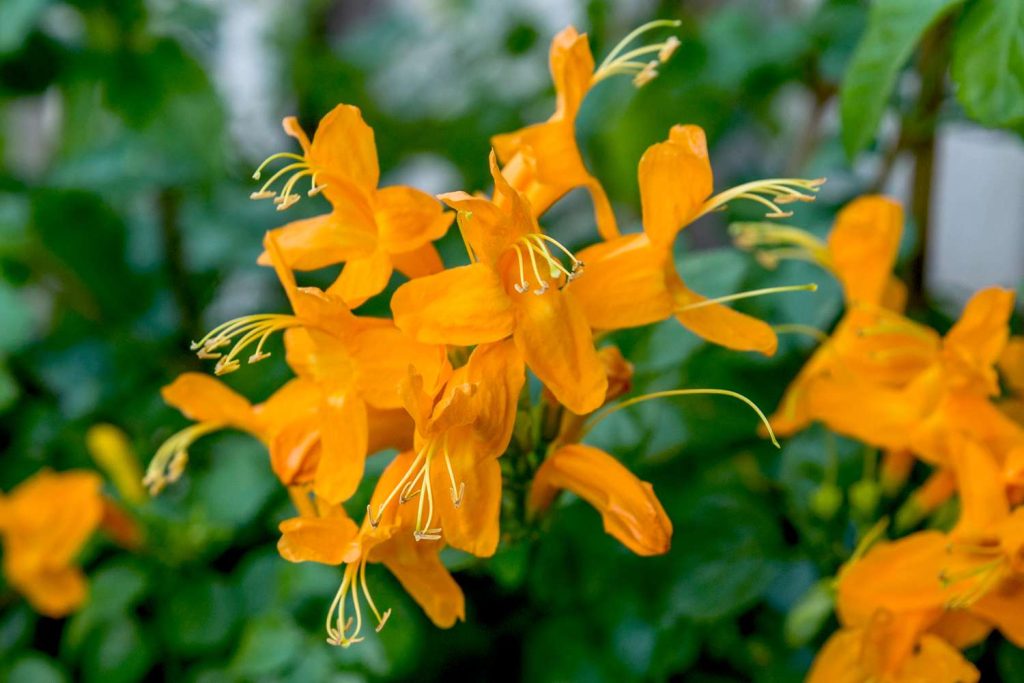
Cape Honeysuckle, scientifically known as Tecoma capensis, is a fast-growing evergreen shrub that produces clusters of tubular flowers in shades of orange or red. These vibrant flowers are highly attractive to hummingbirds.
Cape Honeysuckle thrives in full sun and well-draining soil. It is drought-tolerant once established and can withstand a wide range of soil conditions.
With its showy flowers and ability to attract hummingbirds, Cape Honeysuckle is a popular choice for adding color and liveliness to gardens and landscapes.
Common Name: Cape Honeysuckle
Scientific Name: Tecoma capensis
Growing Zones: 9 – 11
Sun: Full sun
Soil: Well-draining
Colors: Orange, red
Height: Up to 10 feet
Spread: 6 – 10 feet
Plant Type: Shrub
27. Scarlet Sage
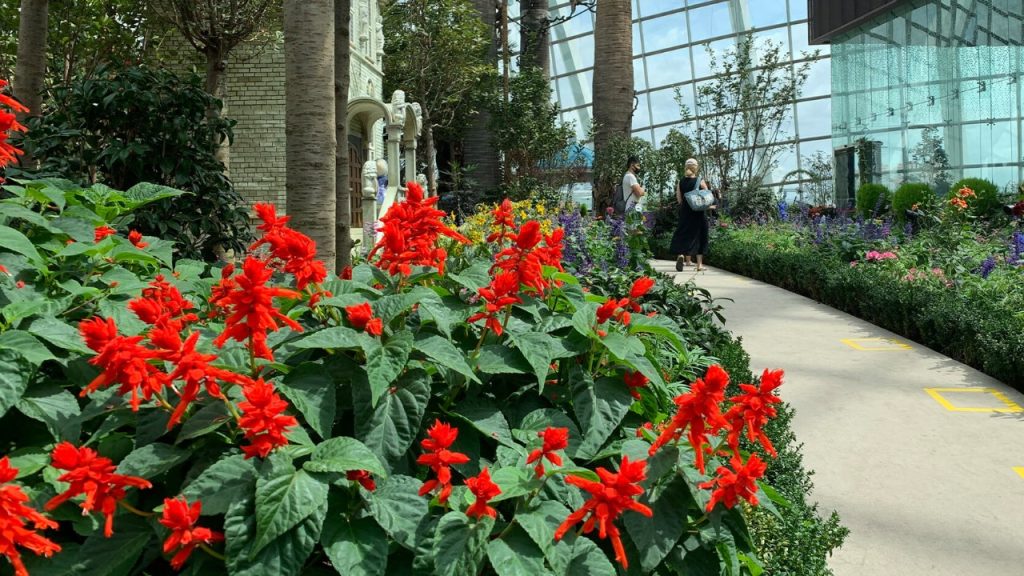
Scarlet Sage, scientifically known as Salvia coccinea, is a versatile annual plant that produces vibrant red, tubular flowers. These flowers are highly attractive to hummingbirds, which are drawn to their nectar.
Scarlet Sage prefers full sun to partial shade and well-draining soil. It is relatively low-maintenance and can be used in borders, containers, or mass plantings to create eye-catching displays.
Hummingbirds will flock to Scarlet Sage, making it a wonderful addition to any hummingbird garden or landscape.
Common Name: Scarlet Sage
Scientific Name: Salvia coccinea
Growing Zones: Annual
Sun: Full sun to partial shade
Soil: Well-draining
Color: Red
Height: 1 – 3 feet
Spread: 1 – 2 feet
Plant Type: Annual
28. Fuchsia

Fuchsia is a genus of flowering plants that includes both annuals and perennials. These plants are known for their unique, pendant flowers that come in various color combinations, such as pink, purple, red, and white.
Fuchsia plants prefer partial shade to full shade and well-draining soil. They require regular watering to keep the soil consistently moist.
The distinct shape and vibrant colors of Fuchsia flowers make them highly attractive to hummingbirds, who can access the nectar within the pendulous blooms.
Common Name: Fuchsia
Scientific Name: Fuchsia
Growing Zones: Varies depending on species
Sun: Partial shade to full shade
Soil: Well-draining
Colors: Pink, purple, red, white
Height: Varies depending on species
Spread: Varies depending on species
Plant Type: Annual or perennial, depending on species
29. Pineapple Sage
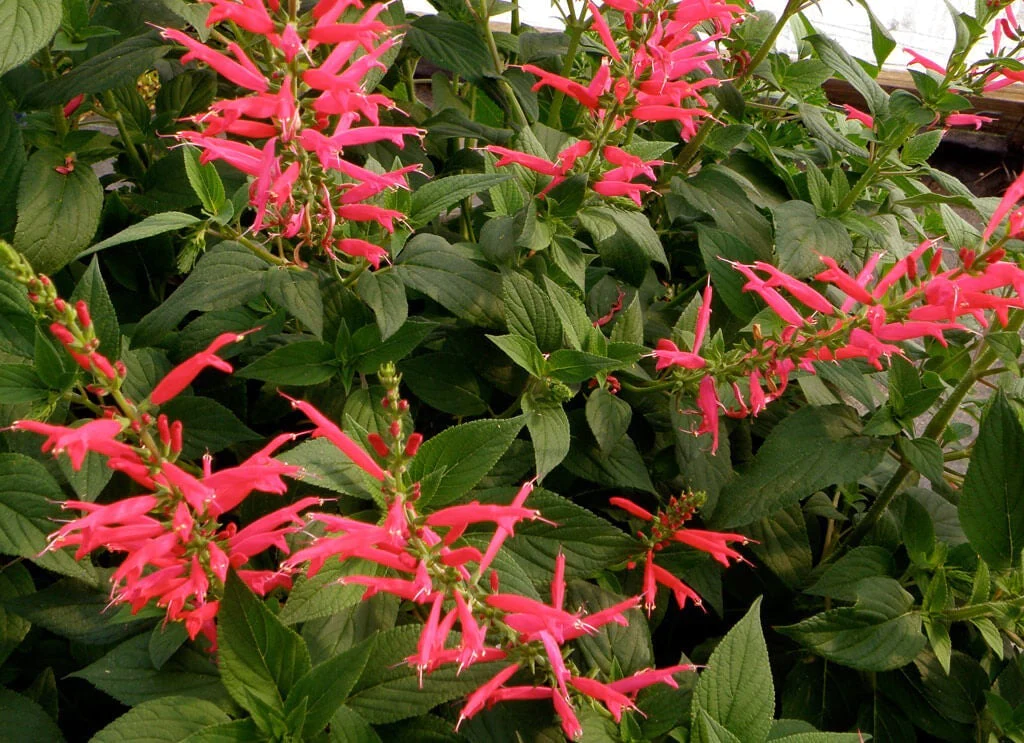
Pineapple Sage, or Salvia elegans, is a perennial herb that produces bright red tubular flowers and fragrant leaves. The flowers’ sweet fragrance and nectar-rich blooms make them highly attractive to hummingbirds.
This herb prefers full sun to partial shade and well-draining soil. It can be grown in herb gardens, borders, or containers, adding both ornamental value and culinary uses.
Pineapple Sage’s vibrant red flowers will surely catch the attention of hummingbirds, providing them with a delightful source of nectar.
Common Name: Pineapple Sage
Scientific Name: Salvia elegans
Growing Zones: 8 – 11
Sun: Full sun to partial shade
Soil: Well-draining
Color: Red
Height: 2 – 3 feet
Spread: 1 – 2 feet
Plant Type: Perennial
30. Scarlet Beebalm
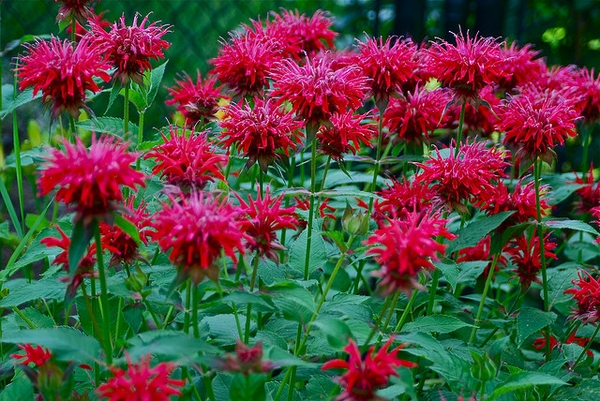
Scarlet Beebalm, or Monarda didyma, is a striking perennial plant that attracts hummingbirds with its showy red flowers. These flowers have a unique tubular shape that makes them accessible to hummingbirds’ long beaks.
Scarlet Beebalm prefers full sun to partial shade and moist, well-draining soil. It is relatively low-maintenance and can be used in borders, meadow plantings, or pollinator gardens.
The vibrant red flowers of Scarlet Beebalm are a hummingbird magnet and will undoubtedly bring life to your garden.
Common Name: Scarlet Beebalm
Scientific Name: Monarda didyma
Growing Zones: 4 – 9
Sun: Full sun to partial shade
Soil: Moist, well-draining
Color: Red
Height: 2 – 4 feet
Spread: 1 – 2 feet
Plant Type: Perennial
